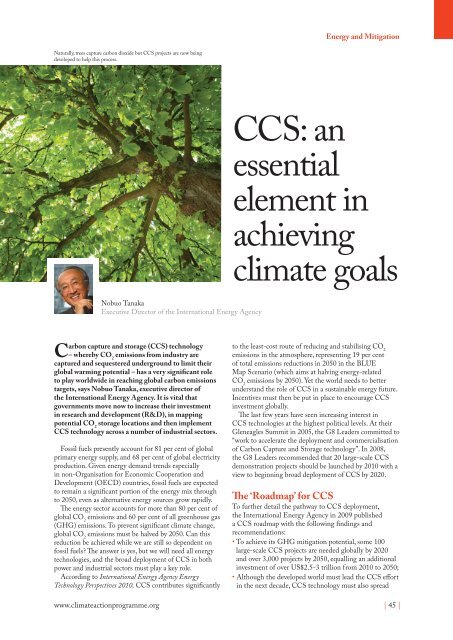Climate Action 2010-2011
You also want an ePaper? Increase the reach of your titles
YUMPU automatically turns print PDFs into web optimized ePapers that Google loves.
Energy and Mitigation<br />
Naturally, trees capture carbon dioxide but CCS projects are now being<br />
developed to help this process.<br />
CCS: an<br />
essential<br />
element in<br />
achieving<br />
climate goals<br />
Nobuo Tanaka<br />
Executive Director of the International Energy Agency<br />
Carbon capture and storage (CCS) technology<br />
– whereby CO 2<br />
emissions from industry are<br />
captured and sequestered underground to limit their<br />
global warming potential – has a very significant role<br />
to play worldwide in reaching global carbon emissions<br />
targets, says Nobuo Tanaka, executive director of<br />
the International Energy Agency. It is vital that<br />
governments move now to increase their investment<br />
in research and development (R&D), in mapping<br />
potential CO 2<br />
storage locations and then implement<br />
CCS technology across a number of industrial sectors.<br />
Fossil fuels presently account for 81 per cent of global<br />
primary energy supply, and 68 per cent of global electricity<br />
production. Given energy demand trends especially<br />
in non-Organisation for Economic Cooperation and<br />
Development (OECD) countries, fossil fuels are expected<br />
to remain a significant portion of the energy mix through<br />
to 2050, even as alternative energy sources grow rapidly.<br />
The energy sector accounts for more than 80 per cent of<br />
global CO 2<br />
emissions and 60 per cent of all greenhouse gas<br />
(GHG) emissions. To prevent significant climate change,<br />
global CO 2<br />
emissions must be halved by 2050. Can this<br />
reduction be achieved while we are still so dependent on<br />
fossil fuels? The answer is yes, but we will need all energy<br />
technologies, and the broad deployment of CCS in both<br />
power and industrial sectors must play a key role.<br />
According to International Energy Agency Energy<br />
Technology Perspectives <strong>2010</strong>, CCS contributes significantly<br />
to the least-cost route of reducing and stabilising CO 2<br />
emissions in the atmosphere, representing 19 per cent<br />
of total emissions reductions in 2050 in the BLUE<br />
Map Scenario (which aims at halving energy-related<br />
CO 2<br />
emissions by 2050). Yet the world needs to better<br />
understand the role of CCS in a sustainable energy future.<br />
Incentives must then be put in place to encourage CCS<br />
investment globally.<br />
The last few years have seen increasing interest in<br />
CCS technologies at the highest political levels. At their<br />
Gleneagles Summit in 2005, the G8 Leaders committed to<br />
“work to accelerate the deployment and commercialisation<br />
of Carbon Capture and Storage technology”. In 2008,<br />
the G8 Leaders recommended that 20 large-scale CCS<br />
demonstration projects should be launched by <strong>2010</strong> with a<br />
view to beginning broad deployment of CCS by 2020.<br />
The ‘Roadmap’ for CCS<br />
To further detail the pathway to CCS deployment,<br />
the International Energy Agency in 2009 published<br />
a CCS roadmap with the following findings and<br />
recommendations:<br />
• To achieve its GHG mitigation potential, some 100<br />
large-scale CCS projects are needed globally by 2020<br />
and over 3,000 projects by 2050, equalling an additional<br />
investment of over US$2.5-3 trillion from <strong>2010</strong> to 2050;<br />
• Although the developed world must lead the CCS effort<br />
in the next decade, CCS technology must also spread<br />
www.climateactionprogramme.org | 45 |












